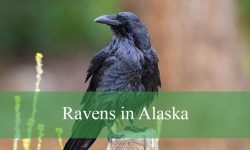North Carolina is home to a diverse range of lizard species, from small, secretive skinks to agile anoles and striking horned lizards. Each species has unique adaptations that help it thrive in the state’s forests, coastal plains, and urban areas.
Many of these lizards are easily spotted in everyday environments, such as backyards, gardens, and parks, while others remain elusive, hiding under leaf litter or burrowing in sandy soils. Understanding their characteristics and habitats can make identifying them much easier.
This guide highlights 18 types of lizards in North Carolina, offering detailed descriptions, identification tips, and insights into their behaviors, sizes, and preferred habitats. It provides a comprehensive look at the state’s reptile diversity for wildlife enthusiasts and nature observers.
Different Types of Lizards Found in North Carolina
Green Anole (Anolis carolinensis)
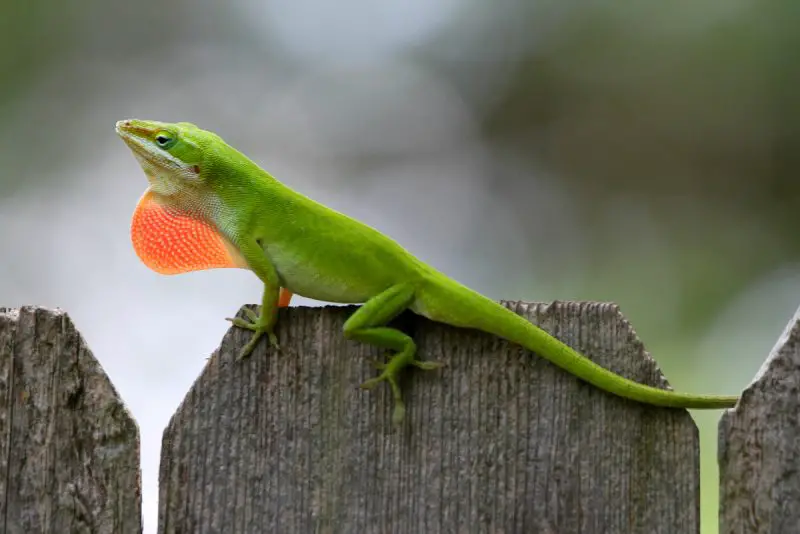
The Green Anole is the only anole species native to North Carolina and is commonly seen throughout the state, particularly in the coastal and Piedmont regions. It is a slender lizard capable of changing its color from bright green to brown depending on temperature, stress, and environmental conditions. Adults typically measure 5 to 8 inches in length, with males slightly larger and often displaying a pinkish throat fan, called a dewlap, used in territorial and mating displays.
This species is easily recognized by its smooth body, pointed snout, and long tail. Unlike the invasive Brown Anole, the Green Anole has unpatterned, uniform coloring and a more elegant appearance. Its color-changing ability sometimes leads to confusion with chameleons, though the two are unrelated. Males are territorial and frequently perform head-bobbing and push-up movements to assert dominance over rivals.
Green Anoles occupy a variety of habitats in North Carolina, from forests and shrublands to backyards and gardens. They are particularly common around fences, walls, and vegetation where insects are abundant. Diurnal and dependent on warm temperatures, Green Anoles are widely distributed across both rural and urban areas of the state.
Brown Anole (Anolis sagrei)

The Brown Anole is a non-native species in North Carolina, originally introduced from the Caribbean, and is most commonly found in coastal and urban areas. Adults range from 5 to 9 inches long, with males typically larger and more robust than females. Their coloration is generally brown to gray with darker markings, often forming diamond or stripe-like patterns. Males display a bright orange or red dewlap, which is particularly noticeable during territorial or mating displays.
This lizard is easily distinguished from the native Green Anole by its shorter, stockier body, rougher scales, and consistently brown coloration. The tail often shows banding, and its movements are quick and jerky. Brown Anoles are highly aggressive toward Green Anoles, often displacing them from lower perches and forcing them higher into vegetation.
In North Carolina, Brown Anoles are most frequently observed in coastal counties and urbanized areas. They thrive in sunny spots with ample ground cover such as rocks, fences, and garden beds. Their adaptability and prolific reproduction have allowed them to spread gradually inland, making them a well-established non-native species along the state’s coastal regions.
Eastern Fence Lizard (Sceloporus undulatus)
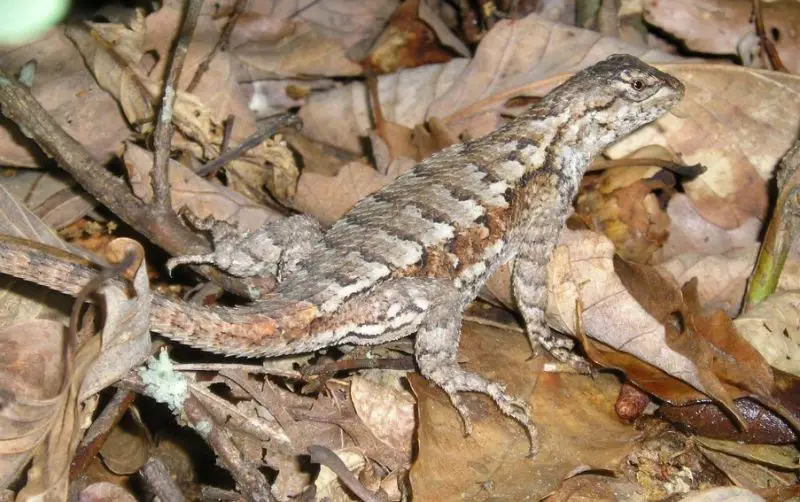
The Eastern Fence Lizard is a medium-sized species commonly found in pine forests, open woodlands, and sandy clearings throughout North Carolina. Adults typically measure 4 to 7.5 inches long and have rough, keeled scales that give the body a spiny texture. Their coloration ranges from gray to brown, often with darker crossbands along the back and tail that provide excellent camouflage in their natural habitats.
Males can be identified by the bright blue patches on their sides and belly, which are especially prominent during the breeding season. Females and juveniles are generally duller in color, blending in with tree bark, leaf litter, and forest floor debris. These lizards are agile climbers and frequently dash up tree trunks or rocks when disturbed, making them somewhat elusive.
Eastern Fence Lizards are commonly seen basking on logs, stumps, rocks, and fence posts in sunny areas. They feed on insects and other small invertebrates, foraging actively during the day. In North Carolina, they are widely distributed but are particularly abundant in sandy, pine-dominated habitats where they can easily blend with their surroundings.
Six-lined Racerunner (Aspidoscelis sexlineatus)
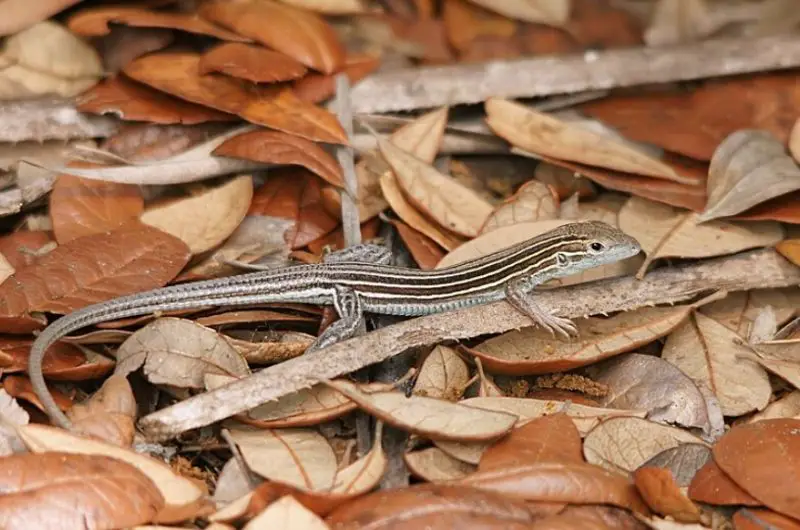
The Six-lined Racerunner is a fast, active lizard that thrives in hot, sunny areas throughout North Carolina. Adults measure 6 to 10 inches in length, with long, slender bodies, whip-like tails, and six distinct yellow or greenish stripes running from head to tail over a dark brown or black background, giving the species its name.
This lizard is one of the most energetic species in the state, constantly on the move during the day. Its remarkable speed makes it difficult to observe closely, as it dashes quickly across open ground. Unlike other lizards, it rarely climbs, relying instead on agility and rapid movement to escape predators.
Six-lined Racerunners prefer open, sandy habitats, grasslands, and roadsides with abundant sunlight. They actively hunt insects and other arthropods, often chasing down prey in short bursts. In North Carolina, they are especially common in dry, sunny environments such as pine savannas, dunes, and open scrublands.
Ground Skink (Scincella lateralis)
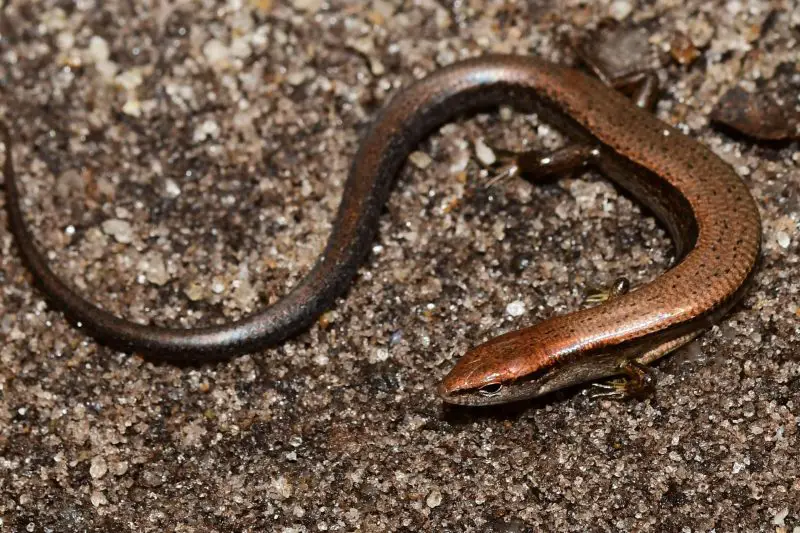
The Ground Skink is one of the smallest lizards in North Carolina, typically measuring only 3 to 5.5 inches in length. Its body is slender and smooth, with a shiny bronze or copper back and a lighter-colored belly. A dark lateral stripe often runs along each side, accentuating its streamlined appearance.
This skink is secretive and spends most of its time hidden under leaf litter, logs, and other ground cover. Unlike other lizards that climb or bask openly, the Ground Skink is more likely to be seen darting quickly through dry leaves. Its long, fragile tail can detach easily as a defense mechanism when threatened.
Ground Skinks are widespread throughout North Carolina, especially in wooded areas, gardens, and moist habitats with abundant leaf litter. They feed on small insects, spiders, and other invertebrates, actively foraging at ground level. Despite their small size and inconspicuous nature, they play an important role in controlling insect populations in their ecosystems.
Five-lined Skink (Plestiodon fasciatus)

The Five-lined Skink is one of the most common lizards in North Carolina, particularly in forested habitats and suburban areas. Adults typically measure 5 to 8.5 inches in length, with smooth, shiny scales and long tails. Juveniles are easily recognized by their bright blue tails and bold yellow or white stripes running along the body, while adults often lose much of the vivid coloration and become darker.
This skink has a slender body with five distinct stripes that gradually fade with age, especially in older males. During the breeding season, males may develop reddish-orange coloration around the jaws. Primarily ground-dwelling, they can frequently be seen basking on logs, tree trunks, and leaf litter in wooded environments.
Five-lined Skinks are widespread across North Carolina, from upland forests to backyards and parks. They feed mainly on insects and spiders, using quick, agile movements to capture prey. Though sometimes secretive, they are among the most commonly observed lizards in shaded trails and forested areas.
Southeastern Five-lined Skink (Plestiodon inexpectatus)

The Southeastern Five-lined Skink is closely related to the common Five-lined Skink and is primarily found in North Carolina’s coastal plain. Juveniles display bright blue tails, while adults retain stripes that become less distinct with age. Adults typically measure 5 to 8.5 inches long, similar in size to the common Five-lined Skink.
Identification can be challenging, but this species often retains its stripes longer into adulthood compared to the typical Five-lined Skink. Subtle differences in scale patterns are noticeable to herpetologists. Like its relative, males may develop reddish coloration on the head during the breeding season.
Southeastern Five-lined Skinks thrive in sandy soils, maritime forests, and coastal scrub habitats. They prefer warmer, open environments and are commonly seen near dunes, pine flatwoods, and barrier islands along North Carolina’s coast, making them a familiar lizard in these areas.
Broad-headed Skink (Plestiodon laticeps)

The Broad-headed Skink is the largest skink in North Carolina, often reaching lengths of 6 to 13 inches. Its most distinctive feature is the wide, triangular head, particularly prominent in adult males. During the breeding season, males develop bright orange to red coloring on their heads, making them highly noticeable.
Juveniles resemble Five-lined Skinks, with bright blue tails and stripes, but adults often lose these markings and become more uniformly olive-brown. Their large size, stocky build, and distinctive head shape distinguish them from other skinks. They are skilled climbers and are more arboreal than many other skink species, frequently found in trees.
Broad-headed Skinks prefer hardwood forests, where they bask on branches, stumps, and logs. They feed on insects, spiders, and other invertebrates, occasionally foraging in the canopy. In North Carolina, they are widespread but most commonly observed in wooded habitats with abundant trees and decaying logs.
Eastern Glass Lizard (Ophisaurus ventralis)

The Eastern Glass Lizard is the most commonly encountered glass lizard in North Carolina. Despite its snake-like appearance, it is a legless lizard, typically measuring 18 to 43 inches long. Its body is long and slender, covered with smooth, shiny scales that give it a glossy look. Unlike snakes, it has movable eyelids and external ear openings, which help with identification.
This species is usually tan to greenish, often with dark stripes or speckling along the body. Its tail is very fragile and can break off easily when threatened, earning it the name “glass lizard.” Unlike snakes, it cannot unhinge its jaws and feeds mainly on insects, spiders, and other small invertebrates.
Eastern Glass Lizards inhabit sandy soils, grasslands, pine flatwoods, and open forests throughout North Carolina. They are often found in coastal regions but can also occur inland where suitable habitat exists. Secretive by nature, they spend much of their time hidden under vegetation or in underground burrows, emerging during warm days to bask or forage.
Coal Skink (Plestiodon anthracinus)
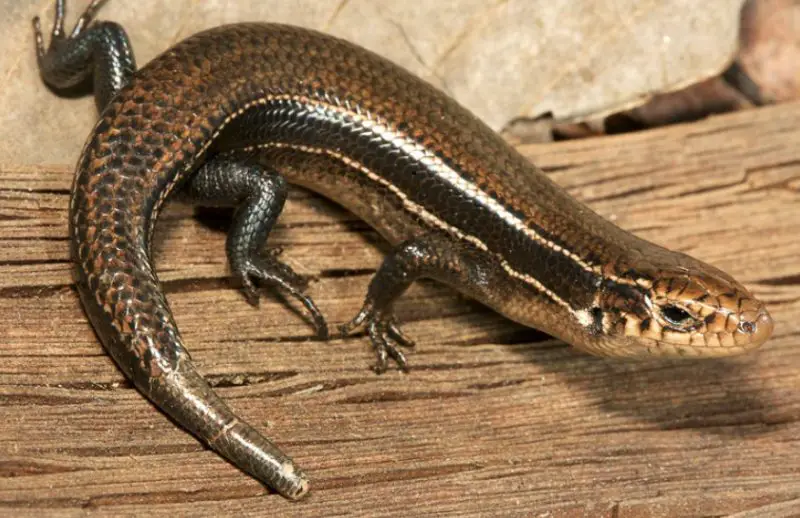
The Coal Skink is one of the less common skinks in North Carolina, primarily found in the hilly and mountainous regions of the western part of the state. Adults typically measure 5 to 7 inches long, with smooth, shiny scales and a relatively short head. Their body is brown to dark brown with four light stripes running along the back and sides, while the tail is usually a uniform color.
Unlike other striped skinks, the Coal Skink has a wide dark band along each side that extends onto the tail, making it easier to distinguish. Juveniles may show faint bluish coloration on the tail, though it is not as bright as in Five-lined Skinks. During the breeding season, males sometimes develop reddish tones on the head.
Coal Skinks prefer moist, wooded habitats in foothills and mountainous terrain. They are often found near rocky streams, under logs, or in leaf litter where humidity is high. In North Carolina, they are considered uncommon and are most likely to be encountered on shaded forested slopes in the Appalachian region.
Mimic Glass Lizard (Ophisaurus mimicus)
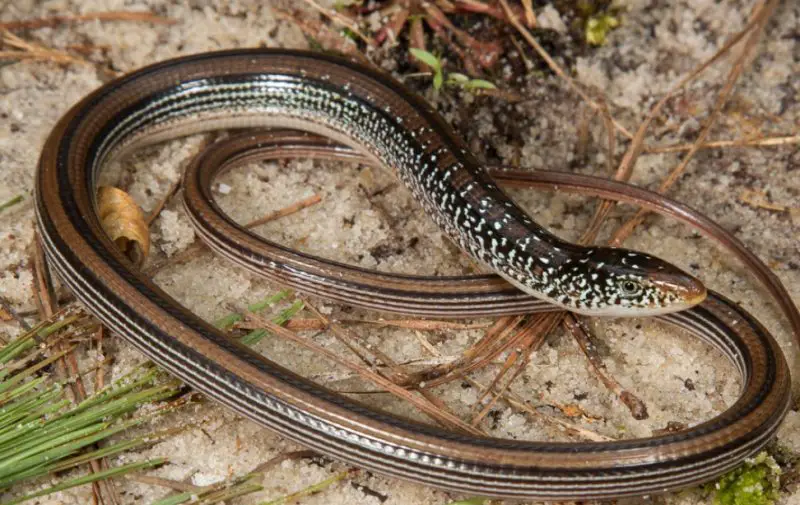
The Mimic Glass Lizard is one of the rarest lizards in North Carolina, with a very limited distribution. Adults grow between 15 and 26 inches long, with slender, legless bodies that resemble snakes. Their coloration is typically tan or brown with darker longitudinal stripes, creating a subtle pattern that aids in camouflage.
This species closely resembles other glass lizards, making identification challenging. It can generally be distinguished by narrow stripes along the sides and fewer scale rows compared to related species. Like other glass lizards, it has movable eyelids and external ear openings, which clearly separate it from snakes.
Mimic Glass Lizards inhabit moist, lowland grasslands and wet meadows with dense vegetation. In North Carolina, they are extremely rare and remain hidden under vegetation or debris. Habitat loss has made this species a conservation concern throughout the Southeast.
Slender Glass Lizard (Ophisaurus attenuatus)

Island Glass Lizard (Ophisaurus compressus)

The Island Glass Lizard is one of the rarest and most range-restricted glass lizards in North Carolina. Adults measure 18 to 30 inches long, with smooth, shiny scales and a long, fragile tail. Their coloration is usually yellowish-brown with faint stripes, often appearing more uniform than that of other glass lizard species.
Identification can be challenging, but the Island Glass Lizard typically has a slightly compressed body and less distinct patterning. Like all glass lizards, it possesses movable eyelids and external ear openings, which clearly distinguish it from snakes. Its body is slightly more flattened compared to the Eastern Glass Lizard.
In North Carolina, this species is confined to coastal regions and barrier islands, giving it a very narrow distribution. It inhabits sandy soils, dunes, and coastal scrub, remaining mostly hidden under vegetation or debris. Due to its restricted range, it is particularly vulnerable to habitat loss and coastal development.
Mole Skink (Plestiodon egregius)
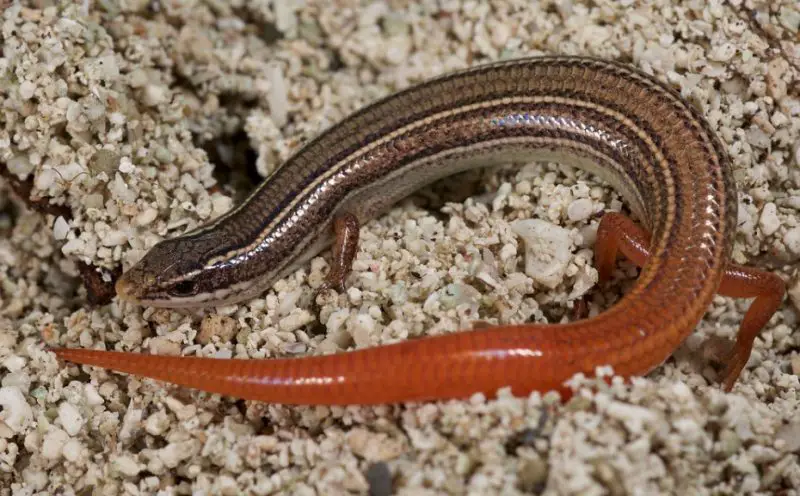
The Mole Skink is a small, secretive skink rarely seen in North Carolina, typically measuring 3.5 to 5.5 inches in length. Its body is slender with smooth scales, and coloration ranges from coppery brown to reddish, often featuring a pink or orange tail in juveniles. The legs are short, and the tail is proportionally long.
This species is adapted for a burrowing lifestyle, spending much of its time beneath the surface. Unlike other skinks that frequently bask, the Mole Skink is largely fossorial, moving under leaf litter, loose soil, or sandy substrates. Its secretive habits make it difficult to observe in the wild.
In North Carolina, Mole Skinks are restricted to the southern coastal plain, inhabiting dry, sandy habitats such as scrublands and pinewoods. They are considered rare and rely on undisturbed sandy soils to survive. Because of their limited distribution and specialized habitat requirements, they are a species of conservation concern.
Mediterranean House Gecko (Hemidactylus turcicus)
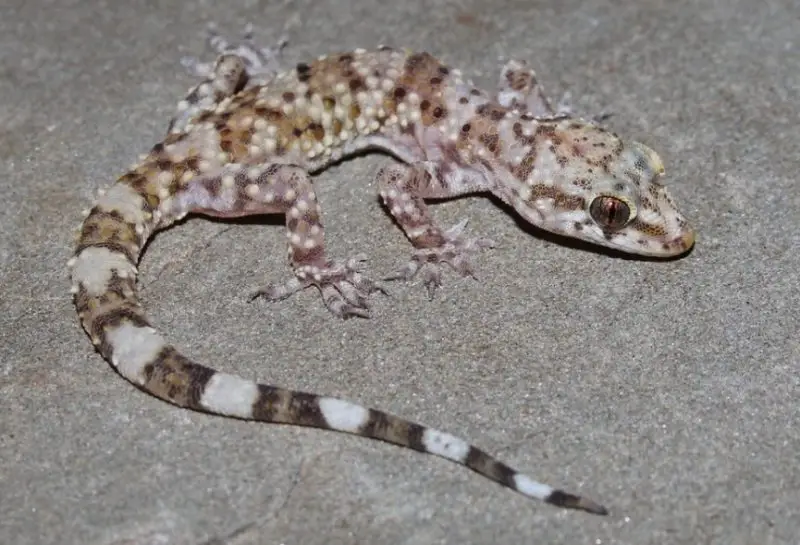
The Mediterranean House Gecko is one of the most widespread non-native lizards in North Carolina, commonly seen around human dwellings. Adults typically measure 4 to 5.5 inches long, with soft, translucent skin that is pale gray or pinkish with darker spots. Their bodies are covered in small bumps, and their large eyes with vertical pupils are well adapted for nocturnal activity.
This species is easily identified by its flattened body, wide toe pads, and bumpy skin texture. Unlike native lizards that are primarily diurnal, the Mediterranean House Gecko is nocturnal, often seen hunting insects near porch lights, windows, and street lamps. Its sticky toe pads allow it to cling to walls, ceilings, and glass surfaces with ease.
Mediterranean House Geckos are firmly established in North Carolina’s urban and suburban areas, especially in coastal regions. They thrive in warm environments and have adapted well to living alongside humans. Their habit of hunting around artificial lights, where insects gather at night, makes them one of the most commonly observed gecko species in the state.
Tropical House Gecko (Hemidactylus mabouia)
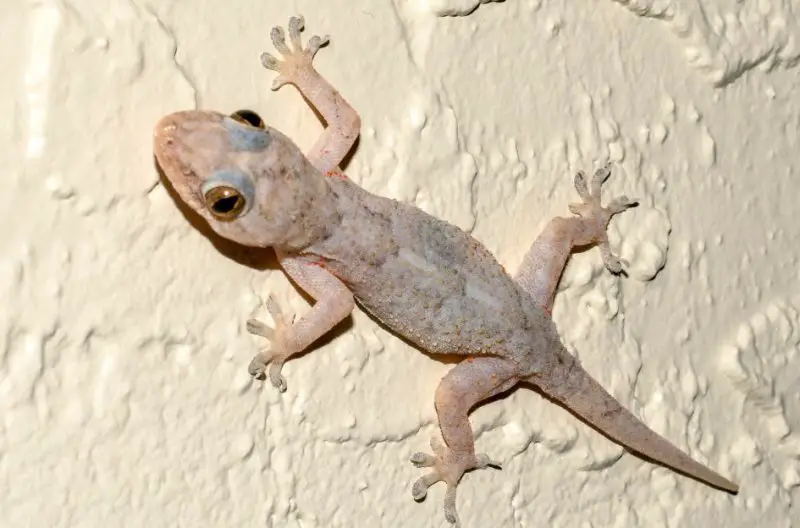
The Tropical House Gecko is a non-native species in North Carolina, though less common than the Mediterranean House Gecko. Adults typically measure 4 to 5 inches long and have smooth, somewhat translucent skin, usually pale gray or tan. Their markings are subtle, giving them a more uniform appearance compared to Mediterranean House Geckos.
This gecko is nocturnal and frequently seen on walls and buildings at night, especially in coastal towns. Like other house geckos, it has large toe pads that allow it to climb vertical surfaces with ease, and it actively hunts moths, flies, and other insects attracted to artificial lights. Its large, lidless eyes provide excellent night vision.
In North Carolina, the Tropical House Gecko has been reported mainly in a few coastal communities. While less widespread than the Mediterranean House Gecko, populations are gradually establishing in warm urban areas. Its adaptability suggests that its range may expand further along the state’s coastal plain in the coming years.
Indo-Pacific Gecko (Hemidactylus garnotii)
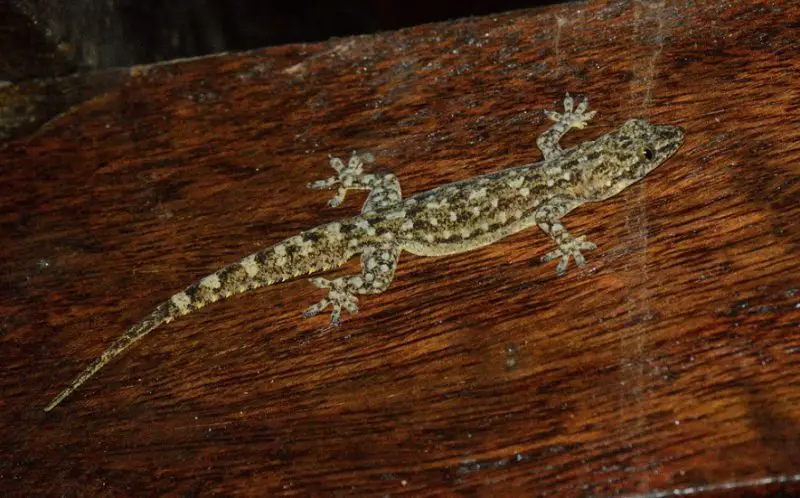
The Indo-Pacific Gecko is one of the rarest introduced lizards in North Carolina, with only a few documented sightings. Adults measure 4 to 5 inches long and have smooth, uniform skin that is typically grayish or brownish with minimal to no patterning. Their bodies are more slender and streamlined compared to other house geckos.
This species is parthenogenetic, meaning females can reproduce without males, allowing even small populations to persist. Like other geckos, it has wide toe pads for climbing and is nocturnal, feeding on insects attracted to artificial lights. Its behavior closely resembles that of the Mediterranean and Tropical House Geckos, though it is far less common.
In North Carolina, the Indo-Pacific Gecko has only been reported in a few isolated coastal areas. It is not considered established and remains extremely rare compared to other house gecko species. Its limited presence indicates that while it can survive in the state, it has not yet spread widely.
Texas Horned Lizard (Phrynosoma cornutum)
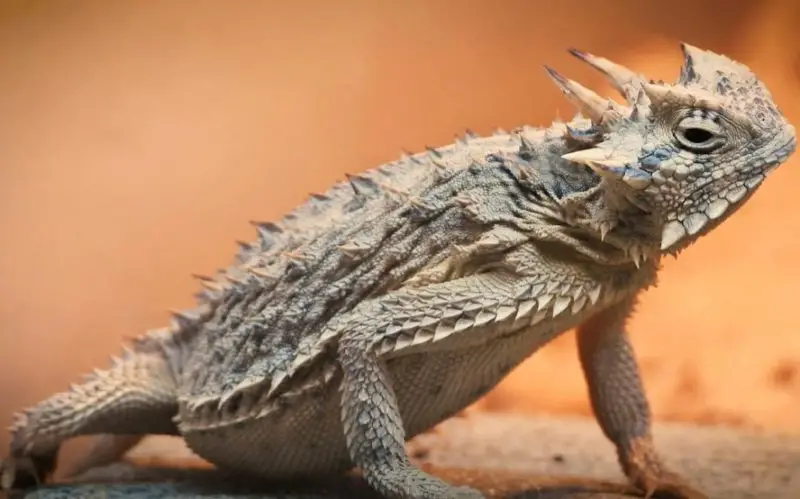
The Texas Horned Lizard is a highly distinctive reptile native to the arid Southwest, but in North Carolina it is non-native and only appears in rare, isolated reports. Adults typically measure 3 to 5 inches long and are easily recognized by their squat, broad bodies, spiny scales, and the prominent horns on the back of the head. Their coloration ranges from sandy tan to reddish-brown, providing effective camouflage in dry, open environments.
Identification is straightforward due to their unique body shape and defensive adaptations. When threatened, they may inflate their bodies to appear larger or flatten against the ground to blend with their surroundings. In extreme cases, they can even squirt blood from the corners of their eyes to deter predators. Their short tail, rounded body, and crown of horns distinguish them from all other lizards.
Texas Horned Lizards primarily inhabit deserts, prairies, and scrublands, feeding mainly on ants, particularly harvester ants, as well as other insects like beetles. While North Carolina lies well outside their natural range, any sightings in the state are likely due to human introduction rather than an established population.
FAQs about Lizards in North Carolina
What types of lizards are native to North Carolina?
North Carolina hosts several native lizards, including the Green Anole, Eastern Fence Lizard, Five-lined Skink, Southeastern Five-lined Skink, Broad-headed Skink, Six-lined Racerunner, and Ground Skink. These species thrive in forests, open fields, coastal areas, and even urban settings, each displaying unique behaviors and habitat preferences.
Are there any non-native lizards in North Carolina?
Yes, several non-native species have established populations, particularly in urban and coastal areas. Notable examples include the Mediterranean House Gecko, Tropical House Gecko, Brown Anole, Indo-Pacific Gecko, and occasionally the Texas Horned Lizard, which appears through human introduction.
Where can I commonly see lizards in North Carolina?
Lizards are frequently spotted in backyards, gardens, parks, forests, and sandy coastal habitats. Green Anoles and Brown Anoles are common in urban environments, while skinks and racerunners are more likely to be seen in wooded or open sunny areas.
Are lizards in North Carolina dangerous to humans?
No, lizards in North Carolina are harmless. They are non-venomous and generally avoid human contact, feeding primarily on insects and other small invertebrates. They play a valuable role in controlling pest populations.
How can I identify different lizard species?
Identification relies on size, coloration, body shape, markings, and behavior. For example, Green Anoles can change from green to brown, Brown Anoles are stockier with banded tails, and Five-lined Skinks have blue tails as juveniles. Observing habitat and daily activity patterns also aids identification.
When are lizards most active in North Carolina?
Most lizards are diurnal, active during the day when temperatures are warm. Exceptions include nocturnal species such as Mediterranean and Tropical House Geckos, which hunt insects around artificial lights at night.
Do any lizards in North Carolina climb trees or walls?
Yes, several species are skilled climbers. Green Anoles, Brown Anoles, Broad-headed Skinks, and house geckos frequently climb trees, fences, and walls, using their specialized toe pads for traction.
How can I attract lizards to my garden?
Providing shelter like rocks, logs, and leaf litter, along with access to water and an abundance of insects, can attract lizards. Avoiding chemical pesticides also helps create a lizard-friendly environment.






